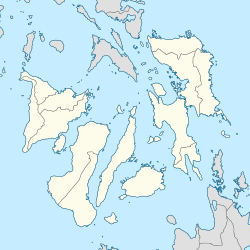Archdiocesan Shrine of Santa Teresa de Avila
| Archdiocesan Shrine of Santa Teresa de Avila | |
|---|---|
| Santa Teresa de Avila Parish Church | |
 Church facade in 2017 | |
| 10°14′38.4″N 123°50′52.3″E / 10.244000°N 123.847861°E | |
| Location | Barangay Poblacion, Talisay |
| Country | Philippines |
| Denomination | Roman Catholic |
| History | |
| Status | Parish church |
| Founded | August 16, 1836 |
| Cult(s) present | Teresa of Avila |
| Associated people |
|
| Architecture | |
| Functional status | Active |
| Style | Classical Graeco Roman |
| Years built | 1836 - 1848 |
| Completed | 1848 |
| Specifications | |
| Length | 72 meters (236 ft) |
| Width | 33 meters (108 ft) |
| Nave width | 13 meters (43 ft) |
| Materials | Coral stones |
| Administration | |
| Archdiocese | Cebu |
| Clergy | |
| Priest in charge | Romel Kintanar[1] |
The Archdiocesan Shrine of Santa Teresa de Avila, previously known as Santa Teresa de Avila Church, is a Roman Catholic church located in Talisay, Cebu, Philippines. Built in 1836 until 1848, architecturally, the church is in classical Graeco-Roman style, featuring the facade's two bell towers connected by a porch with two supporting columns on the foyer. On October 15, 2007, it was declared an archdiocesan shrine and pilgrims could receive plenary indulgence for a year.
Design[edit]

The church was made from coral stones and contained embellished interiors and five gilded altars. Its original design was cruciform with two semicircular transepts[2] and the twin belfries on each side of the façade,[3] with a connecting balustraded portico that is supported by two columns on the main entrance, are its prominent feature.[2][4] Inside, hanging above the crossing is a large round chandelier.[2] According to Filipinas Heritage Library, the church used "round arch, rectangular piers with engaged shafts, and an arcade."[5] Felipe Redondo, writing in the late 19th century, described its architecture as Doric (classical Graeco-Roman) in style.[4]
The church's structure was remodeled, and two new wings were added on each side of the main nave. Its original stonewalls were preserved, its old arched windows and side entrances still visible to this day.[2]
History[edit]

The church's name was in honor of Teresa of Avila, its patron saint.[6] Talisay during the Spanish times was a property of Augustinian friars and a visita of San Nicolas,[7] which was a district south of then municipality of Cebu and to which it was later annexed.[8] The area separated from San Nicolas when the local population boomed[2] and on August 16, 1836, the parish was declared independent under Juan Soriano[7] by virtue of a royal decree signed on April 25, 1836. Interestingly the tomb of another priest possibly the predecessor of Juan Soriano is still extant inside one of the small chapels inside the church. [2]
Construction began in 1836 and the works were completed in 1848.[3] When a typhoon caused the destruction of the church's roof made of clay tiles, it was renovated with iron sheets in 1877 and in 1894, the interiors were decorated.[6] Towards the conclusion of World War II, the building sustained heavy damage to all parts of the church and the nearby convent did not survive the war. One of the few parts of the church that sustained little damage was the facade which still remains in its original state.[2][6] Post-war restoration efforts were carried out by Teofilo Camomot and because of damage sustained during World War 2 the roof was lowered significantly.[2]
Archdiocesan shrine[edit]
On October 15, 2007, coinciding its fiesta celebration, the parish was declared as an archdiocesan shrine by Cardinal Ricardo Vidal, then Archbishop of Cebu. Pilgrims who visited the church on certain days of the month between the declaration date until October 15, 2008 would receive plenary indulgence.[9]
References[edit]
- ^ Campo, Liv G. (March 15, 2012). "18th century bell of Sta. Teresa de Avila Parish missing?". The Freeman. Retrieved June 10, 2019.
- ^ a b c d e f g h Balaanong Bahandi: Sacred Treasures of the Archdiocese of Cebu. Cathedral Museum of Cebu, Inc. and University of San Carlos press. 2010. ISBN 978-9715390187. Retrieved June 10, 2019.
- ^ a b Mayol, Ador Vincent (April 17, 2019). "Visita Iglesia in Cebu: A pilgrim's path". Inquirer.net. Retrieved June 10, 2019.
- ^ a b Sendino, Felipe Redondo y (1886). Breve reseña de lo que fue y de lo que es la Diócesis de Cebú en las Islas Filipinas (in Spanish). Establecimiento Tipográfico del Colegio de Sto. Tomás.
- ^ "Filipinas Heritage Library | Biblio". www.filipinaslibrary.org.ph. Retrieved 2019-06-10.
- ^ a b c Miller, Lucy Urgello (2010). Glimpses of Old Cebu: Images of the Colonial Era. University of San Carlos Press. ISBN 9789715390200.
- ^ a b Galende, Pedro G. (1987). Angels in stone: architecture of Augustinian churches in the Philippines. G.A. Formoso Pub. ISBN 9789718575000.
- ^ Oaminal, Clarence Paul (August 24, 2018). "The Battle of Tres de Abril Series - April 10, 1898 (Easter Sunday) Part 3". Philippine Star. Retrieved June 10, 2019.
- ^ "Sta. Teresa de Avila Parish in Talisay declared an Archdiocesan Shrine". Philippine Star. October 17, 2007. Retrieved June 10, 2019.
External links[edit]
 Media related to Saint Teresa of Ávila Church in Talisay, Cebu at Wikimedia Commons
Media related to Saint Teresa of Ávila Church in Talisay, Cebu at Wikimedia Commons- Archdiocesan Shrine of Santa Teresa de Avila on Facebook



